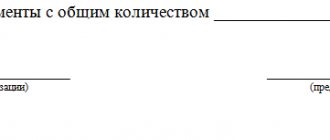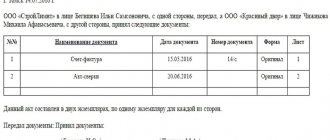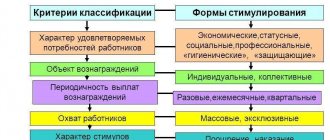Hello! In this article we will talk about such a concept as an employee’s personal file.
Today you will learn:
- What is called a personal file and in what cases should it be kept;
- What documents should be contained in it;
- How much and how to store files.
Not all categories of employers are required to maintain personal files of their employees. But for the effectiveness of team management, it is advisable to form them. Today we will discuss how to do it correctly.
Content
- Personal file: what is it and why keep it
- Who should I register for?
- Who has access to business
- Providing cases to law enforcement agencies
- Registration of a personal file
- What should be in an employee's personal file
- Samples and forms of documents for personal files
- Order of business
- Logbook: how to keep it
- Electronic personal file
- How to deal with the affairs of dismissed employees
- Conclusion
The procedure for compiling an inventory
Personal files of employees in non-state (non-municipal) companies are classified as archival documents of private property (subparagraph 3, part 1, article 3 and subparagraph 3, part 1, article 9 of the Law “On Archival Affairs” dated October 22, 2004 No. 125-FZ) .
As for their shelf life, it is:
- at least 75 years old, if they were created before 2003 (subclause 3, clause 1, article 22.1 of law No. 125-FZ),
- at least 50 years if they were created after 2003 (subclause 3, clause 2, article 22.1 of law No. 125-FZ).
The procedure for storing archival documents must be organized in accordance with the Basic Rules for the Operation of Organizational Archives, approved by the decision of the board of the Federal Archival Agency dated 02/06/2002 (hereinafter referred to as the Archival Rules). In accordance with clause 6.4.5.1 of the specified Archive Rules, the inventory is the primary accounting document for recording personnel files, as well as for files whose storage period exceeds 10 years.
Based on the above, it is clear that such a register as an inventory for documents with a very long shelf life must be present in the file. To complete the inventory, a unified form is provided, approved by the Archival Rules (Appendices 2, 10).
Read about the storage periods for various documentation in the article “What are the storage periods for documents according to the nomenclature of files?” .
Unlike other valuable documentation (in which the inventory is usually located last on the list), in the personal file it is located at the very beginning. It lists all the documentation filed in the personal file. Thus, the following information about documents is entered into the tabular part of this register:
- serial number;
- index;
- date of compilation (or deadlines and storage period);
- title;
- sheet numbers.
In this case, the inventory usually consists of several pages, which are numbered separately from the end-to-end accounting of pages in the personal file itself. In personal files, documents such as orders/instructions, certificates, statements/petitions, extracts from orders, certificates, etc., are arranged in strict chronological order - from the earliest to the latest. First, all documentation related to hiring is filed, and at the very end, everything related to dismissal is filed.
For forms and types of orders for personnel, please follow the link.
The inventory must be signed by the compiler (usually the same employee who maintains the personal file) with a mandatory decoding of his position and full name. The date of compilation must be indicated - it is entered upon completion of filling out the personal file.
Personal file: what is it and why keep it
First of all, this is a set of documentation that characterizes the employee’s activities at a specific workplace. The case is considered initiated from the moment the first document appears in it. Management is usually carried out by the HR department, less often by the accounting department.
Often a personal file is placed on the same level as a work record book, although this is wrong. The work book does not contain any information other than the past and present place of work, unlike the dossier.
The composition of the personal file changes and is supplemented as the person carries out his work activity.
Who should I register for?
It is mandatory to maintain personal files for those employed in the state civil service. This is required by Russian legislation. Entrepreneurs can regulate this issue by local regulations. This means that HR department employees can only open personal files for key employees.
This group includes:
- Management staff and their replacements;
- Chief specialists;
- Persons who are responsible for property and valuables;
- Employees with prospects for career advancement.
But still, it would be useful to create such dossiers for all employees, since they reflect information about employees that may be required at any time.
Employee questionnaire for personal file
This document is a questionnaire that is filled out by the applicant when applying for a job. In it he must indicate information about himself. After reading the questionnaire, the employer will be able to form a certain impression about the candidate and make an appropriate decision. In addition, the information from the questionnaire is used by personnel department employees to compile a personal file and fill out the personal card of the hired employee. Each employer determines the need to fill out such a document himself, since it is not mandatory when hiring, except for registration for state or municipal service (Article of the Labor Code of the Russian Federation).
The questionnaire for the personal file of an organization employee does not have a unified form. Employers can take as a basis the questionnaire approved for government agencies by order of the Government of the Russian Federation dated May 26, 2005 No. 667-r or independently develop a document form. Developing your own version of the questionnaire is more preferable, since the organization will be able to include in it a list of questions that are needed by a specific department (HR department, legal service, etc.).
The document has a clear structure that allows you to quickly evaluate its content. It consists of several sections. Most often, the questionnaire includes the most significant questions of a social nature: place of residence, education, professional experience, information about close relatives, etc.
When drawing up the questions that will be included in the questionnaire, the employer and authorized officials should not forget about some legal aspects. So, in Art. The Labor Code of the Russian Federation states that it is unacceptable to demand from citizens information concerning their political, religious and other beliefs.
The job applicant must fill out all lines of the application form personally. The document should be filled out legibly and accurately. The compliance of the information entered in the questionnaire with the data specified in the provided documents is checked and confirmed by an employee of the enterprise’s personnel service.
Who has access to business
Only the personnel officer or accountant appointed by order of the manager enters information and submits files to the archive. If confidential information is leaked from the case, all responsibility for this will fall on this person.
To avoid such unpleasant situations, it is better to store personal files in a specially designated room, or in safes and metal cabinets, to which third parties cannot gain access.
In addition, the responsible person is obliged to familiarize each employee with his personal file at least once every 12 months.
Registration of a personal file
Watch a short video on how to register an employee’s personal file and everything will become clear:
Before we talk about managing personal affairs, let’s take a closer look at how to formalize them correctly. The formation of a case begins from the date a person is hired and continues until the moment of his dismissal. For each task, it is better to take a separate folder, or at least a file.
When an HR employee creates a personal file, he must remember that:
- It is better to replace original documents with photocopies, in order to avoid a situation where the original of an important document is lost (there are often cases when original diplomas are lost, and it is not easy to restore them);
- One copy of each document is included in the file;
- Documentation of temporary storage and permanent storage are not stored together;
- It is better that one case does not exceed 4 cm in thickness;
- It is better to keep applications in the same place as documentation.
All personal files should be prepared in the same way, and a log of personal files should be kept in order to avoid the loss of important documentation.
So, a sample of a personal file:
- The cover of the personal file contains the surname and initials of the employee, the date when the case was started;
- If there are no separate folders for storing things, then it is better to place them in one folder in alphabetical order;
- The number of pages should not exceed 250;
- Each folder is marked with a case number.
Documents included in personal records
The personal file of each employee contains the resume and recommendations submitted to him, the questionnaires filled out at the enterprise, a job application, a personal card in the T-2 form, and an order for employment. It is advisable to also include copies of your passport, tax registration certificate, pension certificate, education documents, birth certificates for children, marriage (divorce), driver’s licenses, and others in the folder. All copies must be certified by the HR employee who accepted them and checked them against the originals.
The personal file must contain the employment contract with the employee, as well as all additional agreements concluded with him.
As the employee works, his applications for leave, memos, reports, explanatory notes, acts of offenses, nominations for awards, etc. are filed in the employee’s personal file. If it is necessary to disclose his personal data, the employee must consent to this, which is also must be included in this folder. After dismissal, a letter of resignation and an order from the manager regarding dismissal are also attached here.
The employee’s work record book should be stored separately from his personal file in a specialized cabinet, preferably in a safe, since it is a strict reporting form and is registered in the work record book.
What should be in an employee's personal file
The composition of a personal file is not regulated at the level of regulations. It is strictly approved only for the state. employees. Any organization can use the approved list and decide which documentation to include in the files of its employees and which not.
The list is:
- Photocopy of passport (most often the first page, marital status and place of registration);
- A photocopy of a diploma, advanced training document, etc.;
- Photocopy of SNILS;
- If the employee is liable for military service - a copy of the document confirming this;
- Photocopy of TIN;
- Documentation of passing a professional examination and medical examination (if this is provided for by the company’s activities);
- A certificate stating whether the citizen has a criminal record or lack thereof (if provided for by law);
- A job application written by the employee personally;
- Autobiography;
- A copy of the employment contract;
- A photocopy of the work record;
- Materials about certification (if carried out);
- Employee photographs that are periodically updated;
- Description of personal file.
This list may change and be supplemented, depending on what activities the company conducts and what personnel policy it implements.
In addition, all documents must be placed in the file in chronological order: the very first ones that were included when the person was hired, then those that appeared during his activity.
It is prohibited by law to include in the file information about the personal life of an employee, about his views on politics and religion, if he did not give written consent to this.
Formation of an employee’s personal file
Since a personal file is one of the HR documents, when preparing it you must adhere to the following rules:
- all documents contained in the personal file must be neatly executed and properly secured;
- documents that involve entering data into them (personal card, orders, etc.) should not contain corrections or errors; they cannot be drafts. Entries in such documents can be made by hand or using a computer;
- The LD, which stores copies of the employee’s individual documents, such as an employment contract, must be stored in a place inaccessible to unauthorized viewing of the documents contained in it.
As a rule, all documents in a personal file are filed in a binder or stored in a folder with drawstrings, and they must be located in the sequence established by the instructions.
What should it contain
The personal file may include the following documents:
- personal card form T-2, and it must be created for each employee, regardless of whether personal files are formed at the enterprise;
- copies of personal documents that the employee provides when applying for a job (passport, SNILS, Taxpayer Identification Number, diploma, military ID);
- employee application for employment;
- one copy of the employment contract and additional agreements thereto;
- a copy of the employment order;
- statements and copies of orders reflecting the employee’s movements within the organization (change of job title, transfer, etc.);
- documents evidencing the employee’s right to perform the work assigned to him (driver’s license, medical certificates);
- notes on penalties and awards received by the employee;
- a copy of the dismissal order;
- resignation letter or other document that served as the basis for termination of the employment contract.
Video - composition of a personal file:
Employee personal card in form T-2
As mentioned above, a personal card is a document that must be issued for each employee.
The unified T-2 form is filled out when hiring an employee and contains all the necessary information:
- all personal data of the employee;
- about the employee’s education;
- about the employee's length of service;
- about relatives;
- about place of residence;
- about military registration;
- about work and its changes;
- information about advanced training or training with this employer;
- information about employee vacations;
- information about dismissal.
That is, the personal card contains almost all the information that may be useful in the course of work for a personnel officer or accounting department. Therefore, many employers limit themselves to maintaining this form, into which they simply attach copies of documents. Without indicating in internal documents that it is necessary to create personal files at the enterprise and without regulating the procedure for maintaining them.
Video - how to fill out an employee’s personal card in form T-2:
This will not be a violation, since during the check they only pay attention to the presence of a correctly executed T-2 card.
Order of business
This process includes:
- Making entries in the relevant sections;
- The procedure for removing documentation that has become irrelevant or is no longer needed;
- Checking personal files for the safety of documentation;
- Storing documentation as part of a personal file.
If an employee's personal information changes, they usually report this to the HR department. It is better, of course, to do this in writing. After the HR department employee makes the appropriate entry into the file, the original document is returned to the employee. If necessary, you need to make a copy of the document and attach it to the file.
All entries are made only based on original documentation or copies certified by a notary. Entries are made by hand in black, blue or purple ink, carefully, avoiding blots and corrections. If necessary, the records are certified using the organization’s seal and the signature of the HR department employee.
It is not recommended to use gel pens for writing, as this type of ink is subject to rapid fading.
All sheets that are filed in the file are numbered. And the numbering is reflected in the internal inventory. Such an inventory is compiled to take into account documents that have been stored for more than 10 years.
If the case is being prepared for submission to the archive, all sheets of the internal inventory are also numbered, only separately from the sheets of the case.
Chronology of maintenance
The outer side of the cover is entitled with the full name of the employee. The sample includes the following items:
- indication on the corresponding fields of the cover of the primary data (employee’s full name, photo, dossier number, start and end date of office work);
- fixing the number of numbered sheets;
- registration and attachment of an internal inventory sheet.
According to the standard scheme, the following chronology of management is observed:
- The form is filled out and enclosed.
- An employment contract sheet is drawn up and added.
- An agreement on non-disclosure of trade secrets is added.
Copies of the following documents are added:
- copy of the passport;
- certificate of education;
- military ID or reserve officer ID;
- confirmation of TIN assignment;
- certificate of assignment of an individual state pension insurance number;
- agreement on liability;
- certification materials.
A recent photo of the employee is used for registration. You cannot add a photo that is several years or more old. After the employee is dismissed, the file is closed and archived.
Logbook: how to keep it
It is necessary to take into account personal files opened for employees. Its standard form has not been approved, which means you can take a sample from the Internet or purchase it in a store. The content of each column can be changed depending on the organization.
The log contains: case numbers, their start date, surname and initials of employees and other information. When a personal file is closed, a note is made in the journal: they put a date and enter the reason why the case was closed.
Additional information is usually entered in the “Other” or “Notes” column.
Electronic personal file
Nowadays, many Russian companies have implemented or have begun to implement HR automation. It can hardly be called following fashion, rather a necessity. Employees' personal files are increasingly maintained and stored in computer databases. Paper documents are used, but mostly as reinsurance.
Maintaining and storing personal files in electronic form is, above all, convenient. A HR employee does not need to bite the dust, shifting things around in order to find what he needs. Therefore, one of the absolute advantages of electronic files is the ability to find everything quickly, without wasting time and effort.
It is worth noting that not all documentation can be kept in electronic form; work books, for example, cannot.
If the document must contain the personal signature of the employee, it must also be in paper form.
How to deal with the affairs of dismissed employees
When a person quits, his file is closed, removed from the file and filed. In this case, a certification sheet must be drawn up. It includes data on how many sheets are stitched and numbered. This sheet also indicates whether there are damaged documents in the case, or whether new ones have been attached.
The certification sheet is pasted onto the cover of the case from the inside. The HR employee puts his signature on this sheet.
An employee’s personal file is kept in the archive for 75 years; for managers, this period is usually longer. But at the same time, if on the last working day an employee asks for copies of the necessary documents, this can be done; in this case, the file will not have to be stored, and the archive will be unloaded.
Registration procedure
The cover of the folder with the employee’s completed personal file must contain the following information:
- indicating the employee’s full name in the nominative case (this is considered the title of the personal file);
- possible spelling options for the employee’s first name, last name or patronymic, recorded in documents (change of last name after marriage or its dissolution, and similar cases). For example, Safarova Mahreban Kaniz kyzy (Maria Konstantinovna), Nazarova (Kravchenko) Anastasia Valentinovna, etc.;
- when archiving personal files, stapled folders containing several packages of documents, in addition to the title name, have letter indices indicating that here are the personal files of employees whose last names begin with certain letters: for example, “A” - “K” 2010 G.;
- the dates of hiring and dismissal must coincide with the dates indicated in orders or statements;
- personal files may contain documents whose dates are earlier than the employees were officially hired. In this case, it does not matter when determining deadlines for personal matters;
- according to Article No. 656 of the Model List, personal files of managers do not have a storage deadline, and documents of employees are stored for 75 years from the date of their dismissal, regardless of age.
It is important not to forget to enter documents in chronological order and number all sheets of personal files, which will greatly simplify the process of maintaining them and finding the necessary information.
(Size: 37.0 KiB | Downloads: 18,209) (Size: 16.0 KiB | Downloads: 13,737)










